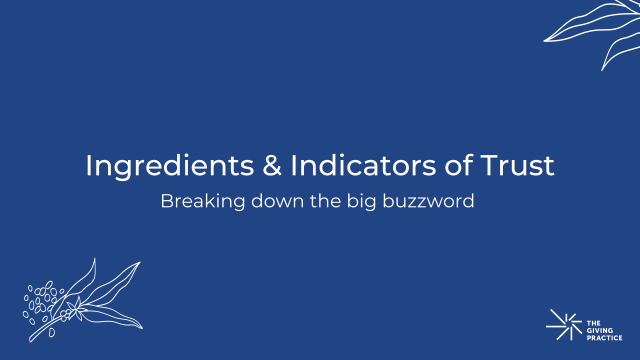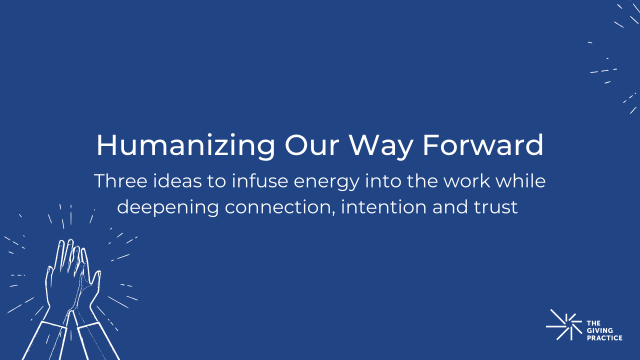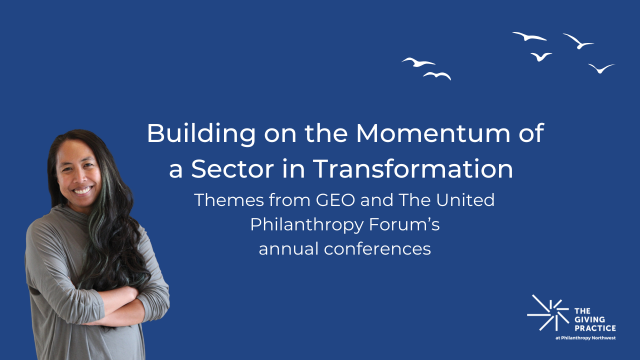
When Brenda Solórzano first joined Headwaters as the founding CEO in 2017, she knew she wanted to do philanthropy differently. “I had a vision to create an entire organization that is rooted in the notion of ceding power, creating more equitable ways to work together and being in authentic relationship with one another. To walk arm in arm as we solve problems together, rather than as grantee and grantor, or staff and board,” she shared with us.
Today the values and practices behind her vision are better known in our sector under the framework of trust-based philanthropy (TBP), and after 7 and a half years of culture- and practice-building at the Headwaters Foundation, Brenda has begun an exciting new chapter at The California Endowment to continue her leadership in our sector.
“A lot of people think TBP was only possible at Headwaters because it was a start-up or because my board was new to philanthropy. And that they can’t do this at their foundation because their circumstances aren’t the same – they’re too large, too small, too urban, too rural. People have so many excuses for why they can’t build a trust-based organization, and if I can do it at The California Endowment, I can shut down some of that thinking.” she said.
As Brenda and TGP Senior Advisors Dawn Chirwa and Mark Sedway – who supported Brenda throughout her tenure at Headwaters – can attest, the process of building new cultures and practices is possible but a far cry from easy.
“There were moments of highs, and then really, I thought I was going to leave Headwaters because of the valleys that we were in,” Brenda shared. “There would be times when I thought, why did I make this so hard for me and my team? It’s way easier to work in a traditional philanthropy. To let the board rubber stamp everything, have metrics we impose on grantees. All of that is easier so why am I doing this the hard way? And it always came back to values. Fundamentally I believed that it was the right thing to do. And I’ve learned in the process that if I always do the right thing, I can’t go wrong.”
Brenda holds a library’s worth of knowledge and lessons learned on what it takes to facilitate change at the people, organizations and systems levels to embrace trust-based philanthropy. From our conversation together, we captured what likely would be just the preface of a single book. Here’s what she shared:
Trust-based philanthropy takes…
...seeing one another’s humanity
“The only way to build a trusting organization is to actually build those deep, meaningful, transparent and authentic relationships. We spent a lot of time building the skill sets for us to see the humanity in each other,” Brenda shared.
She reflected on one exercise in particular that radically changed the way the board engaged with one another:
“We asked board members to tell their life journey in increments of 10 years and it opened up some real and meaningful sharing so it was no longer ‘That’s the old white banker or ‘the doctor who’s the technical expert on health issues,’ but ‘That’s an individual who has also struggled to get to a particular point. Who has also been scared and vulnerable, and who also wants a better future for our children and our families.’ All of a sudden it was no longer me - CEO vs you - board chair vs you - financial consultant. It was just ‘we are.’ We are collectively human, and we all come to this work differently,’” she shared.
Brenda also recognizes that part of being human is having an innate desire to add value, and that in our white dominant structures we often confuse this with exercising power.
“Having authentic conversations about power hoarding, why we do it, why it should be different and what ceding power can look like played a really important role in our journey for both the board and staff,” she shared. “Part of my work at Headwaters was figuring out how to create psychologically safe spaces where people could engage directly and authentically in these types of hard conversations. I also had to make some tough calls when there were people on our team that weren’t willing to be in that space with us. I had to let go of some staff and that’s never easy or fun work.”
...time and patience
Brenda emphasized that none of this work happens overnight. “It takes time to break down paradigms. It takes time to build relationships. It takes time to build trust because we're human, and we will break that trust, and it will take time to rebuild that trust to get back. And then there’s the staff and board transitions. You have new people coming in who hold paradigms outside of our trust-based system, and all of a sudden you’re revisiting familiar questions like, why are we doing this? And how come we don’t have a traditional ROI process? So there’s a lot of back-and-forth before you can actually feel like you're going forward,” Brenda said.
She shared that it took just about five and a half to six years before it felt like the organization was fully embracing TBP.
“It’s a gradual process where first we decided the board would review and approve policy grants. Then slowly, it became policy grants over a certain amount. Now they don’t approve any grants at Headwaters and there’s been a shift in seeing that the hard work isn’t about approving grants. The hard work is about helping the staff solve sticky challenges and collectively figure out strategically how to best deploy resources.”
...a network of support
Throughout her journey, Brenda has not been alone in the work.
“Peer to peer safe spaces were instrumental in helping me feel like I could stick it out. During the early years when I ran into challenges, I was a part of Philanthropy Northwest’s CEO cohort where I could take really hard issues or difficult times I was going through and get advice in a safe space,” she shared. “It’s also important to surround yourself with people that will help the vision come to a reality,” she added.
Brenda was also actively engaged in the early peer networking effort that eventually grew into the Trust-Based Philanthropy Project. She connected with Pia Infante and John Esterle of The Whitman Institute, who were looking to deepen and expand their philosophy of trust-based philanthropy by learning from other funders. Together, alongside The Whitman Institute and the Robert Sterling Clark Foundation, Headwaters Foundation co-founded the Trust-Based Philanthropy Project, an organization dedicated to codifying and amplifying this new approach to philanthropy through ongoing peer learning and exchange.
...vision and fearless leadership
Brenda knew what she was doing was different, and that when you’re doing something outside of the mainstream, there are a lot of unknowns.
“I think this work takes vision and courage. And if you commit unapologetically to your role, you can change anything,” she shared. “I’ve said this before but I was completely unconcerned about getting fired. In my mind, I viewed this as an experiment. If they (the board) hate it and they don't want me to do it, then I might not stay. And if they hate it and they fire me, well, I'll go back to California and get another job. So, there was a fearlessness that I had to practice. I had to be unafraid of tackling the hard things and not knowing how it was going to work.”
Trust-based philanthropy looks and feels…
...energetic and invigorating
When it all comes together, through the hills and the valleys, a trust-based organization feels exciting, energetic and for Brenda, really difficult to leave. “At Headwaters, the board, staff and community we worked in was just so positive that it was really hard to think about walking away from all of it,” she shared.
She provided some more insight into Headwaters’ work and culture in 2024, as a foundation that had fully embraced trust-based philanthropy:
“In 2024, we had split board votes, but we were okay with the tension and the conversation. We voted and the board moved on. The second thing is that we had a real sense of team. It wasn’t Brenda and the staff v. the board. All of us were on the same team, meaning all of us struggled or succeeded as a team.”
She shared that externally, the foundation was continuing to work in ways that served the community more effectively.
“At Headwaters, the team was not spending time serving the board or spending time putting dockets together. We were out in community. Attending events, on the phone with our grantees. And it wasn’t until we did our first grantee perception report and scored in the 90% percentile or higher in every indicator that I realized what we had done.”
As Brenda reflects on her journey at Headwaters Foundation, it's clear that building a trust-based organization is both a challenging and deeply rewarding endeavor. Her unwavering commitment to ceding power, fostering authentic relationships and creating lasting change is a testament to what’s possible when leadership is driven by a bold vision. As Brenda embarks on her next chapter at The California Endowment, her legacy at Headwaters serves as a powerful model for others in the sector. Our Philanthropy Northwest family has mountains of gratitude for Brenda and her leadership.
Here’s to continuing the journey of trust-based philanthropy, one step — and one relationship — at a time.
You can access additional insights from Brenda’s on trust-based philanthropy below:
- Building Trust Means Getting Uncomfortable
- Rigorous Evaluation Versus Trust-Based Learning: Is This a Valid Dichotomy?
- True Philanthropy is More Than Money Delivered Fast
- Making Values Work for Teams – Trust-Based Philanthropy
Looking for support on your trust-based philanthropy journey? Email us at hello@thegivingpractice.org
Looking to begin or deepen your trust-based journey? Learn more about how we can help below.


